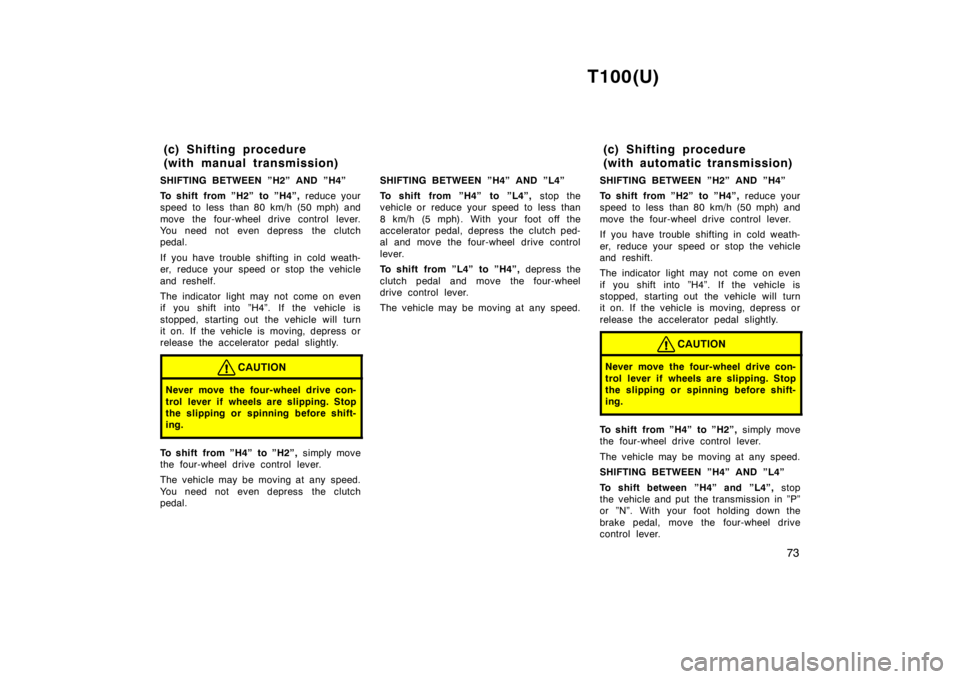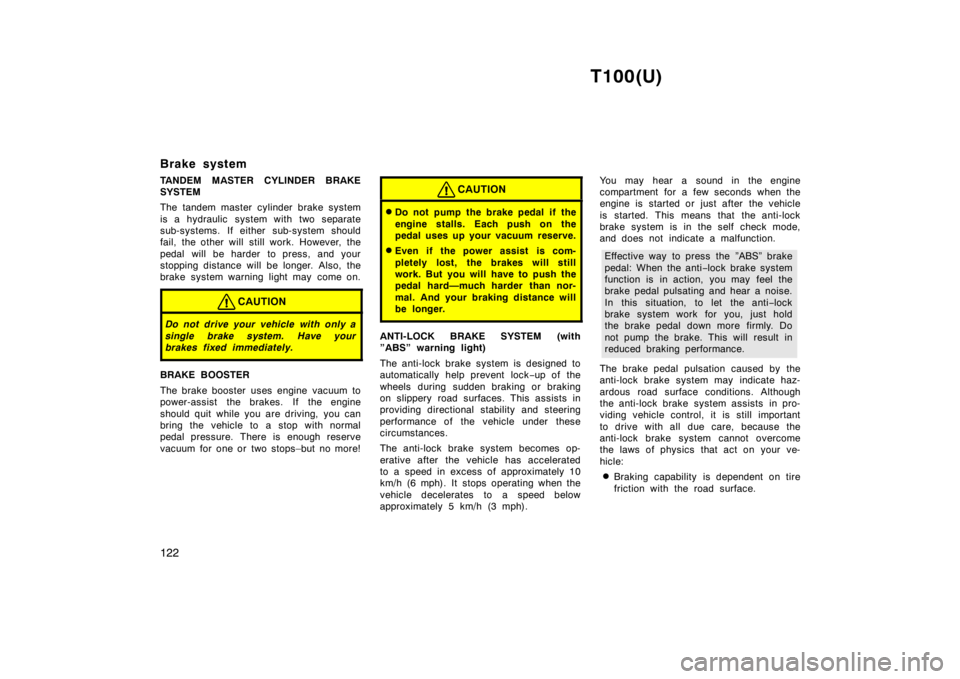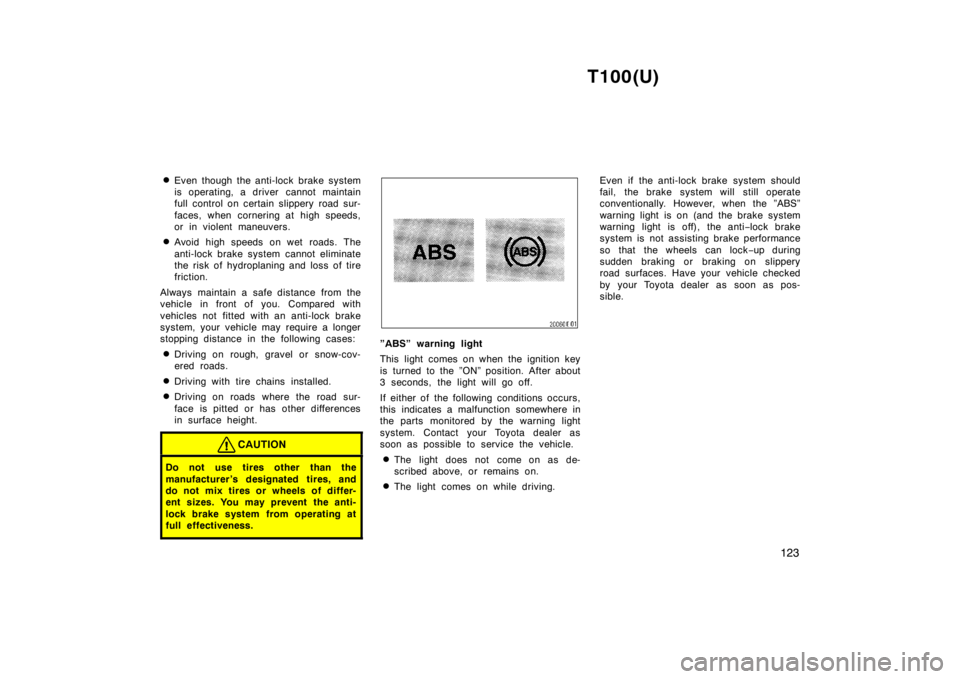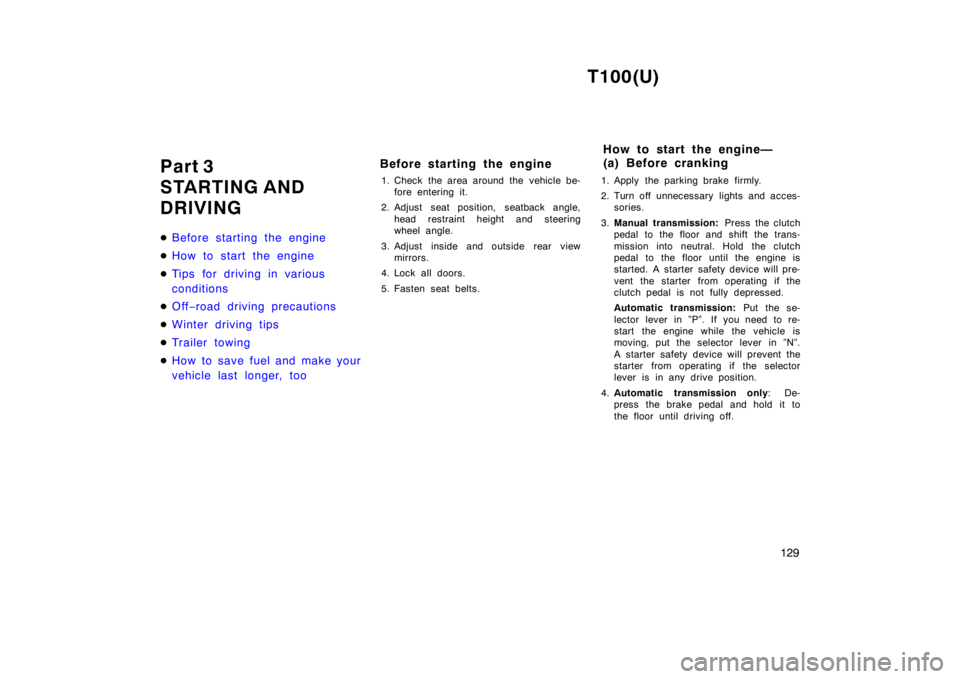1998 TOYOTA T100 brake light
[x] Cancel search: brake lightPage 67 of 214

T100(U)67
Your automatic transmission has a shift
lock system to minimize the possibility of
incorrect operation. This means you can
only shift out of ”P” position when the
brake pedal is depressed (with the ignition
switch in ”ON” position and selector lever
pulled toward you).
(a) Normal driving
1. Start the engine as instructed in ”How to start the engine” in Part 3. The
transmission must be in ”P” or ”N”.
2. With your foot holding down the brake pedal, shift the selector lever to ”D”.
In ”D” position, the automatic transmission
system will select the most suitable gear
for running conditions such as normal
cruising, hill climbing, hard towing, etc.
Always turn the overdrive switch on for
better fuel economy and quieter driving.
Two-wheel drive models–If the engine
coolant temperature is low, the transmis-
sion will not shift into the overdrive gear
even with the overdrive switch on. Four-wheel drive models–If the engine
coolant temperature is low and the vehicle
is travelling at low speed or when the
four-wheel drive control lever is in ”L4”
(four-wheel drive, low range), the trans-
mission will not shift into the overdrive
gear even with the overdrive switch on.
(See ”Four-wheel drive system” in this
Chapter for information of the four-wheel
drive control lever.)
CAUTION
Never put your foot on the accelera-
tor pedal while shifting.
3. Release the parking brake and brake
pedal. Depress the accelerator pedal
slowly for smooth starting.
(b) Using engine braking
To use engine braking, you can downshift
the transmission as follows: � Turn off the overdrive switch. The ”O/D
OFF” indicator light will come on and
the transmission will downshift to the
third gear. �
Shift into the ”2” position. The trans-
mission will downshift to the second
gear when the vehicle speed drops
down to or lower than the following
speed, and more powerful engine brak-
ing will be obtained.
Tw o −wheel drive models—
3RZ −FE engine.....112 km/h (70 mph)
5VZ −FE engine.....117 km/h (73 mph)
Four −wheel drive models—
—Four −wheel drive control lever
in ”H2” and ”H4”.....112 km/h (70 mph)
—Four −wheel drive control lever
in ”L4”.....38 km/h (24 mph)
� Shift into the ”L” position. The trans-
mission will downshift to the first gear
When the vehicle speed drops down to
or lower than the following speed, and
maximum engine braking will be ap-
plied.
Tw o −wheel drive models—
3RZ −FE engine.....54 km/h (34 mph)
5VZ −FE engine.....56 km/h (35 mph)
Four −wheel drive models—
—Four −wheel drive control lever
in ”H2” and ”H4”.....54 km/h (34 mph)
—Four −wheel drive control lever
in ”L4”.....10 km/h (6 mph)
Page 73 of 214

T100(U)73
SHIFTING BETWEEN ”H2” AND ”H4”
To shift from ”H2” to ”H4”,
reduce your
speed to less than 80 km/h (50 mph) and
move the four-wheel drive control lever.
You need not even depress the clutch
pedal.
If you have trouble shifting in cold weath-
er, reduce your speed or stop the vehicle
and reshelf.
The indicator light may not come on even
if you shift into ”H4”. If the vehicle is
stopped, starting out the vehicle will turn
it on. If the vehicle is moving, depress or
release the accelerator pedal slightly.
CAUTION
Never move the four-wheel drive con-
trol lever if wheels are slipping. Stop
the slipping or spinning before shift-
ing.
To shift from ”H4” to ”H2”, simply move
the four-wheel drive control lever.
The vehicle may be moving at any speed.
You need not even depress the clutch
pedal. SHIFTING BETWEEN ”H4” AND ”L4”
To shift from ”H4” to ”L4”,
stop the
vehicle or reduce your speed to less than
8 km/h (5 mph). With your foot off the
accelerator pedal, depress the clutch ped-
al and move the four-wheel drive control
lever.
To shift from ”L4” to ”H4”, depress the
clutch pedal and move the four-wheel
drive control lever.
The vehicle may be moving at any speed. SHIFTING BETWEEN ”H2” AND ”H4”
To shift from ”H2” to ”H4”,
reduce your
speed to less than 80 km/h (50 mph) and
move the four-wheel drive control lever.
If you have trouble shifting in cold weath-
er, reduce your speed or stop the vehicle
and reshift.
The indicator light may not come on even
if you shift into ”H4”. If the vehicle is
stopped, starting out the vehicle will turn
it on. If the vehicle is moving, depress or
release the accelerator pedal slightly.
CAUTION
Never move the four-wheel drive con-
trol lever if wheels are slipping. Stop
the slipping or spinning before shift-
ing.
To shift from ”H4” to ”H2”, simply move
the four-wheel drive control lever.
The vehicle may be moving at any speed.
SHIFTING BETWEEN ”H4” AND ”L4”
To shift between ”H4” and ”L4”, stop
the vehicle and put the transmission in ”P”
or ”N”. With your foot holding down the
brake pedal, move the four-wheel drive
control lever.
(c) Shifting procedure
(with manual transmission)
(c) Shifting procedure
(with automatic transmission)
Page 74 of 214

T100(U)
74
Parking brake
To set: Pull out on the lever.
To release: Press the lock release but-
ton, turn the lever, and push it in.
Before leaving your vehicle, firmly apply
the parking brake. For better holding pow-
er, first depress the brake pedal and hold
it while setting the parking brake.
CAUTION
Before driving, be sure the parking
brake is fully released and the park-
ing brake reminder light is off.
Cruise control
The cruise control allows you to cruise
the vehicle at a desired speed over 40
km/h (25 mph) even with your foot off
the accelerator pedal.
Your cruising speed can be maintained up
or down grades within the limits of engine
performance, although a slight speed
change may occur when driving up or
down the grades. On steeper hills, a
greater speed change will occur so it is
better to drive without the cruise control.
CAUTION
�
To help maintain maximum control
of your vehicle, do not use the
cruise control when driving in
heavy or varying traffic, or on slip-
pery (rainy, icy or snow-covered) or
winding roads.
� Avoid vehicle speed increases when
driving downhill. If the vehicle
speed is too fast in relation to the
cruise control set speed, cancel the
cruise control then downshift the
transmission to use engine braking
to slow down.
TURNING ON THE SYSTEM
To operate the cruise control, push the
”CRUISE ON-OFF” switch. This turns the
system on. The indicator light in the
instrument panel shows that you can now
set the vehicle at a desired cruising
speed. Another push on the switch will
turn the system completely off.
Page 76 of 214

T100(U)
76
RESUMING THE PRESET SPEED
If the preset speed is cancelled by pulling
the control lever or by depressing the
brake pedal or clutch pedal, pushing the
lever up in the ”RES/ACC” direction will
restore the speed set prior to cancellation.
However, once the vehicle speed falls be-
low about 40 km/h (25 mph), the preset
speed will not be resumed.
CRUISE CONTROL FAILURE WARNING
If the ”CRUISE” indicator light in the
instrument cluster flashes when using the
cruise control, there is some trouble in the
cruise control system. Contact your Toyota
dealer and have your vehicle inspected.
To crank the engine without depressing
the clutch pedal, push the switch with
the ignition on.
The switch stays on as long as the igni-
tion is on. And it will automatically turn off
when the ignition is off.
This switch cancels the clutch start sys-
tem, which is designed to keep the starter
motor from operating if the clutch pedal is
not depressed all the way down.
The switch allows the vehicle to be driven
out of difficult situations by cranking the
engine with the clutch engaged.
Never use the switch for normal engine
starting. Be sure to follow the starting
procedure instructed in ”How to start the
engine” in Part 3.
Clutch start cancel switch
(four-wheel drive models
with manual transmission)
Page 122 of 214

T100(U)
122
Brake system
TANDEM MASTER CYLINDER BRAKE SYSTEM
The tandem master cylinder brake system
is a hydraulic system with two separate
sub-systems. If either sub-system s
hould
fail, the other will still work. However, the
pedal will be harder to press, and your
stopping distance will be longer. Also, the
brake system warning light may come on.
CAUTION
Do not drive your vehicle with only a
single brake system. Have your
brakes fixed immediately.
BRAKE BOOSTER
The brake booster uses engine vacuum to
power-assist the brakes. If the engine
should quit while you are driving, you can
bring the vehicle to a stop with normal
pedal pressure. There is enough reserve
vacuum for one or two stops–but no more!
CAUTION
� Do not pump the brake pedal if the
engine stalls. Each push on the
pedal uses up your vacuum reserve.
� Even if the power assist is com-
pletely lost, the brakes will still
work. But you will have to push the
pedal hard—much harder than nor-
mal. And your braking distance will
be longer.
ANTI-LOCK BRAKE SYSTEM (with
”ABS” warning light)
The anti-lock brake system is designed to
automatically help prevent lock −up of the
wheels during sudden braking or braking
on slippery road surfaces. This assists in
providing directional stability and steering
performance of the vehicle under these
circumstances.
The anti-lock brake system becomes op-
erative after the vehicle has accelerated
to a speed in excess of approximately 10
km/h (6 mph). It stops operating when the
vehicle decelerates to a speed below
approximately 5 km/h (3 mph). You may hear a sound in the engine
compartment for a few seconds when the
engine is started or just after the vehicle
is started. This means that the anti-lock
brake system is in the self check mode,
and does not indicate a malfunction.
Effective way to press the ”ABS” brake
pedal: When the anti
−lock brake system
function is in action, you may feel the
brake pedal pulsating and hear a noise.
In this situation, to let the anti −lock
brake system work for you, just hold
the brake pedal down more firmly. Do
not pump the brake. This will result in
reduced braking performance.
The brake pedal pulsation caused by the
anti-lock brake system may indicate haz-
ardous road surface conditions. Although
the anti-lock brake system assists in pro-
viding vehicle control, it is still important
to drive with all due care, because the
anti-lock brake system cannot overcome
the laws of physics that act on your ve-
hicle: � Braking capability is dependent on tire
friction with the road surface.
Page 123 of 214

T100(U)123
�
Even though the anti-lock brake system
is operating, a driver cannot maintain
full control on certain slippery road sur-
faces, when cornering at high speeds,
or in violent maneuvers.
� Avoid high speeds on wet roads. The
anti-lock brake system cannot eliminate
the risk of hydroplaning and loss of tire
friction.
Always maintain a safe distance from the
vehicle in front of you. Compared with
vehicles not fitted with an anti-lock brake
system, your vehicle may r equire a longer
stopping distance in the following cases:
� Driving on rough, gravel or snow-cov-
ered roads.
� Driving with tire chains installed.
� Driving on roads where the road sur-
face is pitted or has other differences
in surface height.
CAUTION
Do not use tires other than the
manufacturer ’s designated tires, and
do not mix tires or wheels of differ-
ent sizes. You may prevent the anti-
lock brake system from operating at
full effectiveness.
”ABS” warning light
This light comes on when the ignition key
is turned to the ”ON” position. After about
3 seconds, the light will go off.
If either of the following conditions occurs,
this indicates a malfunction somewhere in
the parts monitored by the warning light
system. Contact your Toyota dealer as
soon as possible to service the vehicle.
� The light does not come on as de-
scribed above, or remains on.
� The light comes on while driving. Even if the anti-lock brake system should
fail, the brake system will still operate
conventionally. However, when the ”ABS”
warning light is on (and the brake system
warning light is off), the anti
−lock brake
system is not assisting brake performance
so that the wheels can lock −up during
sudden braking or braking on slippery
road surfaces. Have your vehicle checked
by your Toyota dealer as soon as pos-
sible.
Page 129 of 214

T100(U)129
Part 3
STARTING AND
DRIVING �
Before starting the engine
�How to start the engine
�Tips for driving in various
conditions
�Off
−road driving precautions
�Winter driving tips
�Tr ailer towing
�How to save fuel and make your
vehicle last longer, too
Before starting the engine
1. Check the area around the vehicle be- fore entering it.
2. Adjust seat position, seatback angle, head restraint height and steering
wheel angle.
3. Adjust inside and outside rear view mirrors.
4. Lock all doors.
5. Fasten seat belts. 1. Apply the parking brake firmly.
2. Turn off unnecessary lights and acces-
sories.
3. Manual transmission:
Press the clutch
pedal to the floor and shift the trans-
mission into neutral. Hold the clutch
pedal to the floor until the engine is
started. A starter safety device will pre-
vent the starter from operating if the
clutch pedal is not fully depressed.
Automatic transmission: Put the se-
lector lever in ”P”. If you need to re-
start the engine while the vehicle is
moving, put the selector lever in ”N”.
A starter safety device will prevent the
starter from operating if the selector
lever is in any drive position.
4. Automatic transmission only : De-
press the brake pedal and hold it to
the floor until driving off.
How to start the engine—
(a) Before cranking
Page 130 of 214

T100(U)
130
(b) Starting the engine
Before starting the engine, be sure to fol-
low the instructions in ”(a) Before crank-
ing”.
Normal starting procedure
The multiport fuel injection system/sequen-
tial multiport fuel injection system in your
engine automatically controls the proper
air-fuel mixture for starting. You can start
a cold or hot engine as follows:
1. With your foot off the accelerator ped- al, crank the engine by turning the key
to ”START”. Release it when the en-
gine starts.
2. After the engine runs for about 10 se- conds, you are ready to drive.
If the weather is below freezing, let the
engine warm up for a few minutes before
driving.
If the engine stalls...
Simply restart it, using the correct proce-
dure given in normal starting.
If the engine will not start—
See ”If your vehicle will not start” in Part 4.
NOTICE
� Do not crank for more than 30 se-
conds at a time. This may overheat
the starter and wiring systems.
� Do not race a cold engine.
� If the engine becomes difficult to
start or stalls frequently, have the
engine checked immediately.
� Always slow down in gusty crosswinds.
This will allow you much better control.
� Drive slowly onto curbs and, if pos-
sible, at a right angle. Avoid driving
onto high, sharp −edged objects and
other road hazards. Failure to do so
can lead to severe tire damage result-
ing in tire bursts.
� When parking on a hill, turn the front
wheels until they touch the curb so
that the vehicle will not roll. Apply the
parking brake, and place the transmis-
sion in ”P” (automatic) or in first or
reverse (manual). If necessary, block
the wheels.
� Washing your vehicle or driving through
deep water may get the brakes wet. To
see whether they are wet, check that
there is no traffic near you, and then
press the pedal lightly. If you do not
feel a normal braking force, the brakes
are probably wet. To dry them, drive
the vehicle cautiously while lightly
pressing the brake pedal with the park-
ing brake pulled. If they still do not
work safely, pull to the side of the road
and call a Toyota dealer for assistance.
Tips for driving
in various conditions